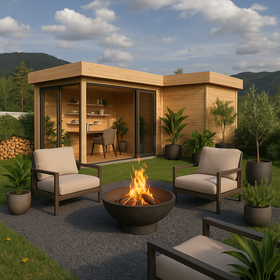512-777-0154

How to Make a Music Room: The Complete Step-by-Step Guide
Every musician dreams of having a space to call their own. A room that feels alive with sound, creativity, and comfort. Here’s how to make a music room: pick a spot, soundproof, and style it your way.
Stick around, because transforming any corner into your personal music haven is easier (and more fun) than you think. Let’s turn your idea into a room that sings back to you.
Planning Your Dream: Music Room Type and Location
Before diving into gear and gadgets, you need a plan. The right room and layout will shape everything about how your space sounds and feels.
Defining the Function
Start by asking what you want this room to do.
- Is it a home studio where you’ll record songs?
- A practice space to refine your skills?
- Maybe a band rehearsal room that needs heavy sound isolation?
- Or perhaps a listening lounge where you just relax and enjoy music?
Knowing the purpose helps you decide how much soundproofing, space, and equipment you’ll need. A recording setup, for example, needs precision and quiet, while a casual jam space can be more flexible.
Scouting the Ideal Room in Your House
Not every room is a natural fit for music. Look for one that’s separate from busy parts of your home and has solid walls.
- Basements are great for sound control, but might need moisture-proofing.
- Garages can handle volume well, but often need insulation upgrades.
- A spare room at the far end of the house can work perfectly for peace and focus.
You want the quietest space you can find so your tunes stay inside and the outside world stays out.
Measuring and Design Planning
Grab a measuring tape and sketch a rough layout. Include doors, windows, outlets, and corners.
Next, plan your equipment placement: where will your speakers, desk, and instruments go?
Use painter’s tape on the floor to test layouts before you commit. It saves you from discovering your keyboard blocks the door halfway through setup.
Step 1: Structural Sound Isolation (True Soundproofing)
Soundproofing is your first real mission. It’s what separates a great music room from an echoing spare room.
Sealing the Perimeter (Air Gaps)

Even small gaps can let sound leak through. Use acoustic sealant around outlets, baseboards, and corners.
Add weather stripping to doors and windows for an airtight fit. You’ll notice the difference the first time your speakers hit a deep bass note.
The Double-Wall Strategy
If you’re building from scratch or remodeling, this step is gold. Create staggered stud walls or use resilient channels to “decouple” wall surfaces.
This breaks the path sound waves use to travel through solid contact. It’s like giving your walls a buffer zone that keeps vibrations from spreading.
Mass and Density in Walls and Ceilings
Soundproofing thrives on mass. The heavier the barrier, the less noise escapes.
Layer soundproof drywall, gypsum board, or Mass-Loaded Vinyl (MLV) for strong sound control. These materials are dense enough to block both mid and low frequencies—no fancy tools required.
Addressing the Floor
Floors can betray even the best soundproofing efforts.
Use rubber underlayment or acoustic isolation pads under carpets or floating floors to absorb vibrations.
Add a thick rug like Andes Indoor Rug for warmth and an extra acoustic boost. It’ll help keep your sound grounded, literally.
Step 2: Optimizing Acoustics (Internal Sound Quality)
Now that sound stays inside, it’s time to make it sound great. Acoustics shape how your music feels in the room.
Understanding Reverberation and Echo

Start by listening. Clap your hands and notice how long the sound lingers.
If it bounces around like you’re in a tunnel, you’ve got reflection issues. Fixing that echo will make your mixes clearer and your music easier to enjoy.
Installation of Acoustic Panels and Absorbers
Focus on the first reflection points, spots where sound travels from speakers to your ears after bouncing off walls.
Mount acoustic panels there and on the ceiling above your desk.
It’s a simple change that gives you a smoother, more professional sound right away.
Strategic Placement of Bass Traps
Bass builds up in corners. It’s sneaky and turns your clear mix into a muddy mess.
Install bass traps (foam or fiberglass panels) in all four vertical corners. They absorb low-end energy and help you hear your mix accurately.
Integrating Diffusion
Absorption tames echoes, but diffusion keeps the sound alive.
Add bookshelves, wooden panels, or acoustic diffusers on the back wall to scatter sound waves. This balances the room so it feels open without being harsh.
Step 3: Essential Equipment Setup and Wiring
Your music room only comes alive when the gear’s in place. A clean setup makes creativity flow easily.
Planning Electrical Needs

Music gear loves power, but clean power.
Make sure your outlets can handle the load and use surge protectors for safety. If possible, dedicate a circuit to your studio so amps and computers don’t trip breakers mid-session.
Ergonomics of the Control Center (Desk)
Your desk is where the magic happens.
Choose one with space for monitors, your computer, and mixing gear. Pair it with a comfortable, adjustable chair that supports long sessions. Good posture means better focus and better music.
Setting Up Studio Monitors and Listening Position
For accurate sound, your speakers and head should form an equilateral triangle.
Keep monitors at ear level and a few inches from the wall. This setup gives you balanced stereo imaging and lets you hear your mix the way it truly sounds.
Connecting Your Audio Interface and Mixer
Keep your cables neat and labeled.
Run your signal like this: Instrument → Audio Interface → Mixer → Monitors. Cable ties or clips can save you from the classic studio spaghetti situation.
Step 4: Furnishing and Music Room Ideas for Small Spaces
Small spaces can sound big with a few clever design moves. It’s all about using every inch wisely.
Multi-Functional Furniture
Choose furniture that works double-duty.
Storage ottomans, heavy bookcases, or acoustic panels that double as art are perfect. They save space while improving acoustics and giving your room character.
Vertical Storage and Wall Mounting
When floor space is limited, think up.
Use guitar wall hangers, floating shelves, and vertical racks to keep things tidy. Your instruments become part of the decor, and your space feels open instead of cluttered.
The Role of Lighting in Mood and Function
Lighting can set the tone for your creativity.
Mix bright LED task lighting for work with warm ambient lights for mood. Add a dimmer switch to shift from recording mode to chill mode in seconds.
Decoration and Personalization
This is where your story lives.
Hang vinyl records, concert posters, or your favorite album art. Add small personal touches like a plant or cozy rug. Your music room should feel like a space where you want to spend hours.
Making Your Music Room a Reality
Creating your own music room is about more than just soundproofing and gear; it’s about building a space that fuels your creativity. From sealing air gaps to hanging your favorite records, every detail adds up to something special.
Whether it’s a tiny studio in the corner of your home or a full-fledged recording space, your dream music room is closer than you think. Start small, stay inspired, and let the music take over.
You may also like:
- What is a Music Room in a House? Guide to Home Practice, Listening, and Studio Design
- How to Build a She Shed (DIY, Kits, and Budget-Friendly Plans)
- Choosing the Perfect Garden House for Your Backyard: Sheds, Greenhouses, Offices, and More
- What is a Man Cave Garage? Design, Decor, and Conversion Ideas





